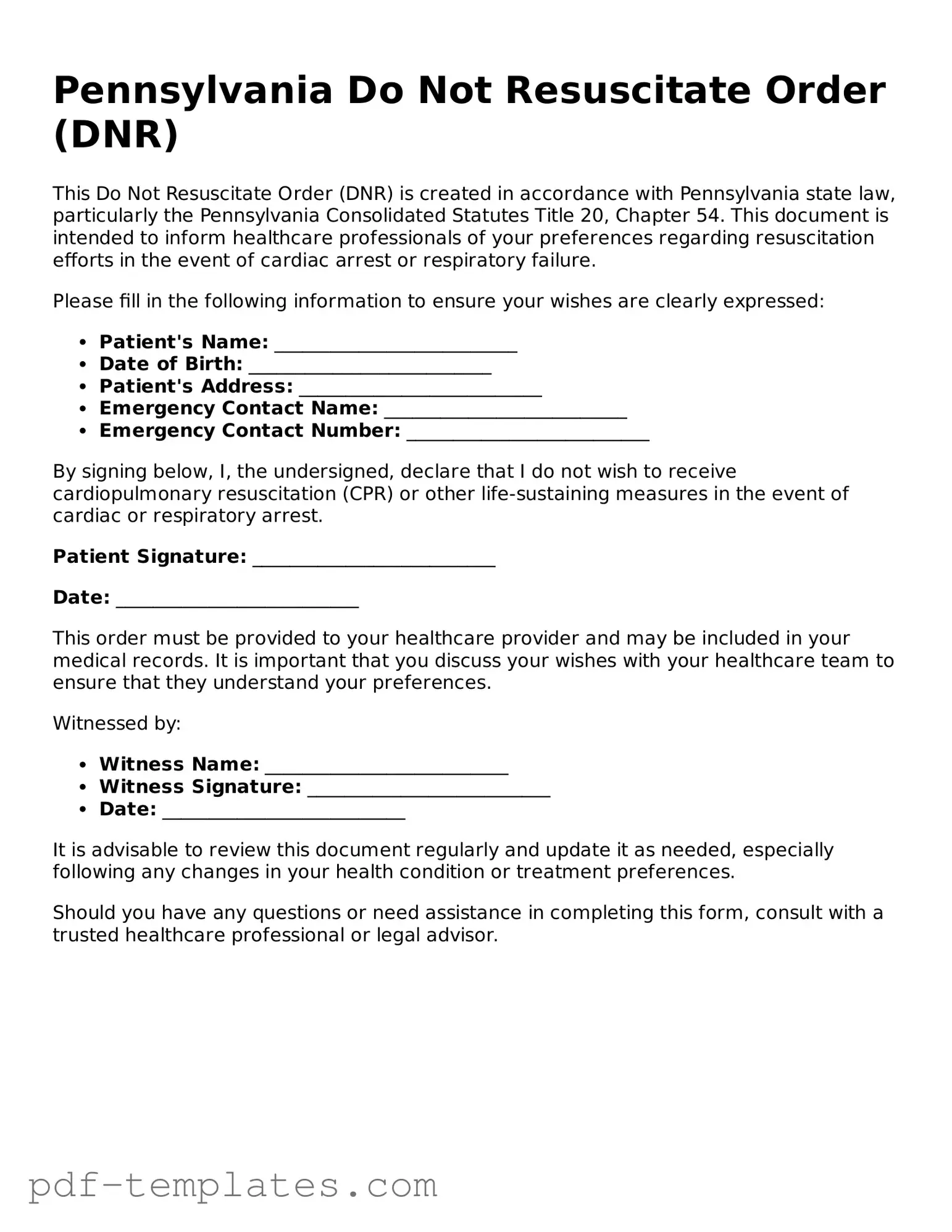The Pennsylvania Do Not Resuscitate Order (DNR) form shares similarities with advance directives, which are legal documents that outline a person's healthcare preferences in the event they become unable to communicate. Like the DNR, advance directives can specify the types of medical treatments a person does or does not want. They serve as a way for individuals to express their wishes regarding life-sustaining measures, ensuring that their preferences are respected by healthcare providers and family members during critical moments.
Another document that resembles the DNR form is the living will. A living will is a specific type of advance directive that focuses on end-of-life care. It provides guidance on the medical treatments an individual wishes to receive or refuse when facing terminal illness or irreversible conditions. Much like the DNR, a living will helps clarify a person's desires regarding resuscitation and other life-saving measures, making it easier for healthcare providers to honor those wishes.
The medical power of attorney is also similar to the DNR form. This document designates a trusted individual to make healthcare decisions on someone’s behalf if they are incapacitated. While the DNR specifically addresses resuscitation efforts, the medical power of attorney can encompass a broader range of medical decisions. Both documents aim to ensure that a person's healthcare preferences are followed, even when they cannot speak for themselves.
The Physician Orders for Life-Sustaining Treatment (POLST) form is another document akin to the DNR. POLST is designed for individuals with serious illnesses and provides specific medical orders regarding treatment preferences. It goes beyond the DNR by covering a wider array of medical interventions, such as the use of antibiotics or feeding tubes. Like the DNR, POLST is intended to communicate a person's wishes clearly to medical professionals, ensuring that their treatment aligns with their values and desires.
Do Not Intubate (DNI) orders also share similarities with the DNR form. A DNI order specifically instructs healthcare providers not to place a patient on a ventilator if they are unable to breathe independently. While the DNR focuses on resuscitation efforts, the DNI addresses a particular aspect of life support. Both documents are critical for patients who want to limit the extent of medical interventions in their care.
Another related document is the Comfort Care Order, which prioritizes patient comfort over aggressive medical interventions. This type of order is often used in hospice or palliative care settings. While a DNR order prevents resuscitation efforts, a Comfort Care Order emphasizes pain management and quality of life. Both documents reflect a patient’s desire for a more peaceful approach to end-of-life care.
The Advance Care Plan is also similar to the DNR form. This document encompasses a broader scope of healthcare preferences, including resuscitation, pain management, and other medical treatments. It serves as a comprehensive guide for healthcare providers and family members, ensuring that an individual’s wishes are understood and respected. Like the DNR, the Advance Care Plan is essential for facilitating discussions about end-of-life care.
The Trader Joe's application form is a vital document for job seekers wishing to join this beloved grocery chain. It outlines necessary information about potential employees and provides an opportunity to showcase their unique skills and experience. Completing the form accurately can significantly increase the chances of landing a position at one of their stores, and you can find the application here: https://documentonline.org/blank-trader-joe-s-application.
The Healthcare Proxy is another document that resembles the DNR. This legal instrument allows an individual to appoint someone to make healthcare decisions on their behalf. While the DNR specifies preferences about resuscitation, the Healthcare Proxy can address a wide range of medical decisions. Both documents empower individuals to ensure their healthcare choices are honored, even when they cannot advocate for themselves.
Lastly, the End-of-Life Care Plan is similar to the DNR form. This document outlines a person's preferences for care during their final days, including decisions about resuscitation and other life-sustaining treatments. Like the DNR, the End-of-Life Care Plan is designed to guide healthcare providers and family members in honoring the individual's wishes, ensuring that their final moments are spent in accordance with their values and desires.
